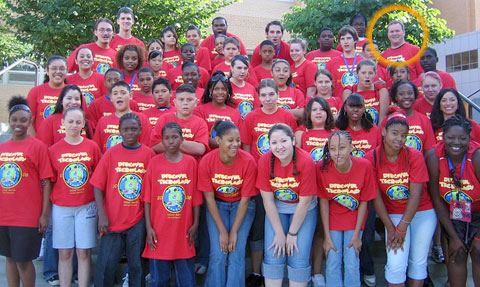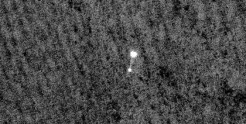Summer Teaching: Discover Technology
I always hope that a pause in the stream of weblog posts will be justified. The last several weeks have been pretty quiet around prefrontal.org, but I do like to think that the time went to a good cause.
For most of July I have been in Lawrence, Kansas as an instructor for the KU Educational Talent Search summer camp ‘Discover Technology’. Talent Search is an educational opportunity program whose main goal is to shepherd students from underrepresented backgrounds though high school and encourage them to engage in post-secondary education. The Discover Technology summer camp is just one part of this year-round program.

I have been an instructor for Discover Technology for almost 10 years now. What brings me back year after year? Well, they pay me for my time, which is a plus. The biggest motivator though is that the course genuinely impacts the lives of the students. The graduation rate of most Kansas City, Kansas high schools is around 50% – Talent Search gets over 95% of their students through to their graduation. That is huge, and definitely worth a little time and effort on my part.
The Emergence of Collaborative Brain Function
It doesn’t take a neuroimaging study to see that adolescents are in a state of flux. It is the time in our lives that takes us from having the mind and body of a child to possessing the full mental and physical faculties of a young adult. In terms of cognitive ability it is during this time that a number of very advanced cognitive abilities are slowly coming online. These abilities include risk perception [consequence representation], metacognition [thinking about thinking], counterfactual thinking [alternate possibilities], and abstract reasoning [higher-order relationships]. In short, we are able to represent a much larger amount of information in new and complex ways, relating this information together in ways that are impossible for a 10-year-old brain.
Now, here’s the $10,000 question: what is going on in the brain to accomplish this?
One piece of that puzzle has been investigated by Beatriz Luna and John Sweeney. They conducted a series of experiments investigating the development of response inhibition by using an antisaccade task with adolescents and adults. The antisaccade task is founded on our natural tendency to move our eyes to the appearance of a new object in our visual field. When we are instructed to move our eyes to these new objects it is called a prosaccade – you are reinforcing an already strong natural behavior. When we are instructed to move our eyes away from the new objects it is called an antisaccade – you are having to inhibit the natural response and engage in the opposite behavior. Naturally, this is much more difficult than the prosaccade condition and is considered by many to be a metric for cognitive flexibility (Hutton and Ettinger, 2006).
There are two main conclusions that I have taken away from the Luna and Sweeney papers. These are conclusions so important that they end up getting cited in just about every paper that I write.
1. Just because an adolescent has shown an adult level of performance does not mean that they are arriving there in an adult-like way. As adolescents get older they tend to make fewer and fewer errors during the antisaccade task. This trend continues until roughly the age of 15, when they have nearly reached an adult level of performance (Luna, Garver, Urban, Lazar, and Sweeney, 2004). However, looking at the PET or fMRI data for a 15-year-old during an antisaccade task tells a different story. The adolescents have different levels of activity in the frontal eye fields, intraparietal sulcus, thalamus, cerebellum, and superior colliculus (Luna et al., 2001). So, while the adolescents could complete the antisaccade task looking like an adult, their brain was accomplishing this feat using an immature pattern of regional activity.
2. A large part of the cognitive maturation observed in adolescence comes from the ability for brain regions to increasingly communicate and collaborate. This runs contrary to frontal theories, which theorize that developmental increases in cognitive ability are largely due to the late maturation of prefrontal executive function Instead, Luna and Sweeney argue that we cannot ignore the functional integration of brain regions in our examination of developmental change (Luna and Sweeney, 2004). This idea is supported by recent DTI studies of the brain, which show that behavioral performance is related to inter-region white matter connectivity (Tuch et al., 2005). As an isolated computational unit a single cortical region is rather useless. It is only through the dynamic exchange of information between regions that advanced cognitive abilities can flourish.
The Luna and Sweeney papers are a staple of my research library. While their evidence is very domain-specific (response inhibition), their conclusions speak volumes about how the brain matures during adolescence. Just because an individual might look and sound like a young adult doesn’t mean that they are one, and hen they finally do make it to adulthood it will have required the combined resources of the whole brain working together.
Refs
* Hutton SB, Ettinger U. (2006). The antisaccade task as a research tool in psychopathology: a critical review. Psychophysiology, May;43(3):302-13. Pubmed: 16805870
* Luna B, Thulborn KR, Munoz DP, Merriam EP, Garver KE, Minshew NJ, Keshavan MS, Genovese CR, Eddy WF, Sweeney JA. (2001). Maturation of widely distributed brain function subserves cognitive development. Neuroimage, 13(5):786-793. Pubmed: 11304075
* Luna B, Garver KE, Urban TA, Lazar NA, Sweeney JA. (2004). Maturation of cognitive processes from late childhood to adulthood. Child Development, Sep-Oct;75(5):1357-72. Pubmed: 15369519
* Luna B, Sweeney JA. (2004). The emergence of collaborative brain function: FMRI studies of the development of response inhibition. Annals of the New York Academy of Sciences, Jun;1021:296-309. Pubmed: 15251900
* Tuch DS, Salat DH, Wisco JJ, Zaleta AK, Hevelone ND, Rosas HD. (2005). Choice reaction time performance correlates with diffusion anisotropy in white matter pathways supporting visuospatial attention. Proceedings of the National Academy of Sciences, Aug 23;102(34):12212-7. Pubmed: 16103359
Quote of the Week – Rousseau
“We are born, so to speak, twice over; born into existence, and born into life; born a human being and born a man.” Jean-Jacques Rousseau, Emile, 1762
Good Science vs Public Awareness (Iacoboni)
In cognitive neuroscience debates are usually quite subdued and people rarely, if ever, point fingers negatively. However, in the last 24 hours there has been a rather dramatic reversal of this norm in a debate that has carried on for several years now: whether Marco Iacoboni and his collaborators overstep the bounds of good science when they bypass peer review and take their findings on Superbowl ads and political candidates directly to the public. Prefrontal.org touched briefly on the topic several months ago in a post entitled “Political Pseudoscience“. Since that time Adam Kolber of the Neuroethics and Law Blog invited Iacoboni to repond to his critics in a post on his weblog. The response was posted this morning, an excerpt of which is printed below: Read the rest of this post »
Writing Tools: Scrivener

Writing is one of the most difficult things that I have to do as a scientist. The problem is that writing is a necessary part of both grant applications and article publication, meaning that we really do live and die by the impact our words have on people. That fact is rarely lost on me as I stare at the laptop screen silently begging my mind to, please, let me have one more great mediocre sentence.
Fortunately I have been able to find several tools that help the writing process along. A good outline of the project before I begin writing is probably the biggest step I have taken in making the final product more coherent. I will write about OmniOutliner sometime in the near future. Also helpful has been the habit of keeping all of my experiment notes in a single notebook, putting relevant information at my fingertips when the act of writing begins. Probably the single most beneficial tool I have found is the writing project management software Scrivener. Having this one program that I can live in while I write has made a gigantic impact on my productivity. Read the rest of this post »
Phoenix Lander Descent Photo

It might not seem immediately obvious, but the above picture is off-the-scale awesome.
The two white blobs in the photo represent the Phoenix Mars lander and its parachute as it was descending into the martian atmosphere. But, wait, where did the photo come from? Well, the Mars Reconnaissance Orbiter just happened to be passing by at 30,000 miles per hour and angled its HiRISE camera over to sneak a few pics. Now that is engineering. It is amazing in its own right that we had a successful landing on Mars after traversing 423 million miles. It is icing on the cake though to have calculations accurate enough to enable this ‘action shot’ of the landing.
Brain Art: AAL Patchwork
This is a rendering done in Slicer of the numerous brain regions defined in the Automated Anatomical Labeling (AAL) digital brain atlas. The AAL atlas was constructed through the identification of major and minor sulci on a T1 MRI with subsequent labeling based on anatomical location. It doesn’t have any relationship to cortical cytoarchitecture, but is still a useful tool to let you know what is in the neighborhood.
I first made this rendering several years ago and since that time I have really fallen in love with it. The picture really brings together the patchwork complexity of the cortical and cerebellar surface. This is an important point – that there is much more to the brain than just two halves or four lobes. It is also very clear that there are asymmetries between the two hemispheres of the brain. The shape of a region in the left hemisphere has little relationship with the configuration of its counterpart in the right hemisphere. I dig it.
If you click on the above image it will take you to a larger version you can download. Enjoy!
* Tzourio-Mazoyer N, Landeau B, Papathanassiou D, Crivello F, Etard O, Delcroix N, Mazoyer B, Joliot M. (2002). Automated anatomical labeling of activations in SPM using a macroscopic anatomical parcellation of the MNI MRI single-subject brain. Neuroimage 15(1): 273-289.
Quote of the Week – Bohr
“The very fact that knowledge is itself the basis for civilization points directly to openness as the way to overcome the present crisis.” – To the United Nations, by Niels Bohr, 1950
The minds of robots
The Sage Center sponsored a talk this afternoon by Daniela Rus entitled “Do Robots Have a Mind?”. Dr. Rus is a Professor at MIT in the Electrical Engineering and Computer Science (EECS) department. She is also a Co-Director of the Computer Science and Artificial Intelligence Laboratory Center for Robotics (CSAIL).
Her talk focused mostly on the many recent advances in robotic reasoning and distributed sensing coming out of her lab. These advances were largely partitioned by modality. She first went over some visual work related to the dynamic color-correction of underwater images based on object distance. She then segued into movement processing as she highlighted the role of proprioception and adaptive algorithms in traversing unknown environments. Other topics that were discussed included self-assembling micro robots, traffic optimization based on distributed data collection, and bovine virtual fencing.
I was left with two impressions at the end of her talk.
First (and most important) is that there is some amazing work going on in robotics right now. The reduction in size and cost of powerful microcontrollers has enabled a revolution in robotic information processing. The emergence of more effective sensing and communications systems has complemented this, yielding more data about the robot’s environment than ever before. The fact that one modular self-disassembly brick has more computing power than entire mainframes of yesteryear speaks volumes about the potential power of these little buggers.
My second thought was that we were moving no closer to recreating the human brain in silicon. An unspoken part of Rus’ talk was that the big advances were more or less unimodal. That is, there were advances in robotic vision or movement, but not so much in tying the two together to deal with highly varied environments. The closest thing I heard was a description of the DARPA car challenge, where autonomous vehicles have to navigate without human input.
At the end of her talk Dr. Rus answered the question of whether robots have a brain with an unqualified ‘yes’. I definitely agree with her, and it is important to recognize that these brains are becoming more complex every year. Still, in my mind the next big step in robotics is going to be an order of magnitude more difficult than previous hurdles. It is going to be the transition from procedural instruction to abstract reasoning. The fact that we have absolutely no idea how to program a computer to reason abstractly speaks volumes about how long it will take to provide a robot with this ability.
Dissertation: Thesis Online
Most of my dissertation experiments will hopefully have a future in peer-reviewed neuroscience journals. The bad news is that it will take a few years to rewrite each experiment and get it out the door. If you are curious about internal state information processing or want to know more about interoceptive development I thought I would post the thesis online as a preview.
“The Integration of Higher Cognition and Internal State Across Development”
Bennett, CM. Doctoral Dissertation, Dartmouth College, 2008.
Bennett-Dissertation-2008.pdf
It is a large PDF file due to the numerous figures and tables included in the text. Keep in mind that the results and conclusions are still in a state of flux pending journal publication. Things may change quite a bit as each runs the gauntlet of the review process. Enjoy!

